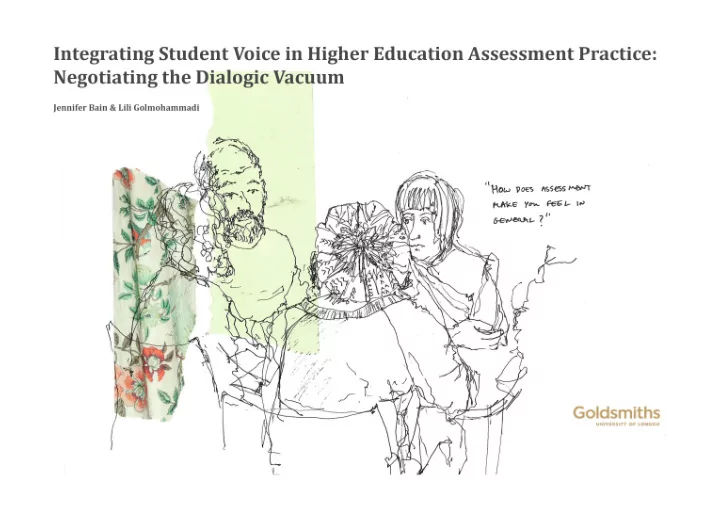

Research Context The Dialogic Vacuum of Assessment
Research Context • Student’s opinions on assessment are given space, epistemological, practical and ontological modes of voice, audience and influence • There are opportunities for students to negotiate what, when and how learning is assessed • Feedback from assessment is collaborative and reflexive • Students are active subjects, with assessment language that of the student. There is possibility for praxis • The approach to assessment includes lecturer-led, peer and self- assessment • Sustainable assessment practice is developed Pertinent Features of Assessment for Becoming (Bain, 2010)
Research Methodology and Themes This paper is drawn from a larger research study running from 2012 to 2015/16: • Examining whether the consequence of current assessment practice was in keeping with the desired consequence of Assessment for Becoming • Exploring if this contributed to the creation of a dialogic vacuum around assessment • Exploring assessment partnerships • Using assessment criteria to empower students • Particular interest in the student perspective and student as co-researcher • Central themes: Ø Develop dialogic assessment practice (Bain, 2010) Ø Create transformative learning spaces (Mezirow, 2000) Ø Support communities of practice (Lave & Wenger, 1999) • Developing guiding principles for assessment practice
Phase 1 Findings • Lack of opportunity for student voice in assessment • Generic ‘meaningless’ nature of assessment criteria, which were rarely used to focus learning • Feedback predominantly focused on grades rather than learning • Overly complex language which made feedback difficult to accesss and apply • The approach to assessment exclusively lecturer-led • Students remain dependent on trying to ‘please’ lecturers as a means to succeed Issues Contributing to Low Consequential Validity
Interim Findings Suggest: • Over time students’ attitudes to assessment became more positive • Engagement with the dialogic approach to assessment appears to increase students understanding of the connection between learning and assessment • Student and Lecturer judgements on quality of work became more consistent • Students described being more in control of their attainment and became pro-active in developing assessment ‘communities of practice’ • The dialogic assessment activities appeared to increase authentic ‘constructive alignment’ • The process provokes critique/evaluation of the DLOs and appears to compensates for broad or vague DLOs • There is a need for carefully constructed ‘modelling’, scaffolding and fading activities • Concerns around a sense of disjunction that a new assessment approach might bring, need to be acknowledged and worked through
Emerging Assessment Principles Student Voice around Assessment Criteria Is development of assessment criteria seen as an integrated part of pedagogy (Watkins and Mortimer, 1999; Boud and Hawke, 2003) that • promotes sustainable assessment (Boud, 2007) ? • Do academics work in partnership with students to develop and refine assessment criteria (Tan, 2007), thus encouraging meta-cognition (Harvey and Burrows, 1992)? • Is student voice at the core of developing and appling assessment criteria? • Does assessment practice help develop spaces and practices that nurture dialogue as integral practices of human learning and daily encounter (Griffiths, 2003 and 2004; Leitch et al , 2005)? • Is student/ academic partnership rooted in dialogic interactions so that the roles of teacher and learner are shared and student voices are validated (Freire, 1973; Keesling-Styles, 2003)? • Are student’s views on assessment given space, voice, audience and influence (Leitch et al , 2005) with opportunities for different modes of voice (Batchelor, 2006)? • Is careful consideration given to the kind of language used in the dialogue of assessment? • Does feedback engage students and lecturers in ‘reflexive and collaborative dialogue’ (Hounsell, 2007: 106) resulting in action, such as adjustments to teaching (Black and Wiliam, 1998)? • Is feedback driven by student needs (Mallett, 2004) and the impact of dialogue, language and feedback on student autonomy considered? • Are there opportunities for interactive learning conversations about assessment criteria, feedback, self-assessment and critical reflection (Robinson and Udall, 2006)? • Is consideration given to a sustainable system of feedback, where ‘students are encouraged to develop a greater sense of ownership of, and thus greater autonomy in, their learning (Hounsell, 2007: 108)? Assessment Methods • Is the range of assessment methods diverse enough to ensure that all students have the opportunity to demonstrate their potential (Race, 1999: 68)? Assessment Approaches • Are student-led assessment approaches considered integral to assessment practice? • Does assessment practice around assessment criteria provide opportunities for modelling, scaffolding and fading (Falchikov, 2007)? • Is assessment future driven allowing students to reflect more critically on assessment practice, and presenting them with an effective opportunity to enhance their learning (Tan, 2007)? • Are students involved in the awarding of marks (Falchikov, 2005)?
Recommend
More recommend